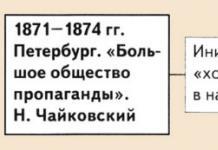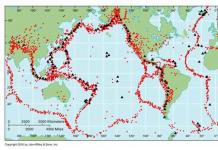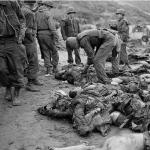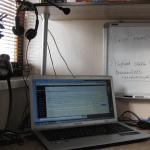Seismic waves- waves that transfer the energy of elastic (mechanical) vibrations in rocks. The source of a seismic wave can be an earthquake, explosion, vibration or impact. Seismic waves are studied in seismology and exploration geophysics. To record vibrations caused by seismic waves, autonomous seismic recorders or receivers connected to seismic stations are used. The speed of wave propagation depends on the density and elasticity of the medium. The speed tends to increase with depth; in the earth's crust it is 2-8 km/s, and when deepening to the mantle it is 13 km/s. In seismology, the study of seismic waves is of independent fundamental interest, and in seismic exploration, waves from artificial sources are directed to geological boundaries of interest to trace them.
Types of seismic waves
There are two main types: body waves and surface waves. In addition to those described below, there are other, less significant types of waves that are unlikely to be found on Earth, but they are important in asteroseismology.
Body waves
Body waves travel through the Earth's interior. The path of the waves is refracted by the different densities and hardness of underground rocks.
P-waves
P-waves(primary waves) - longitudinal, or compression waves. Typically their speed is twice that of S-waves and they can pass through any material. In the air they take the form of sound waves, and, accordingly, their speed becomes equal to the speed of sound. The standard speed of P waves is 330 m/s in air, 1,450 m/s in water, and 5,000 m/s in granite.
S waves
S waves(secondary waves) - transverse waves. They show that the ground is moving perpendicular to the direction of propagation. In the case of horizontally polarized S-waves, the earth moves in one direction and then in the other alternately. Waves of this type can only act in solids.
Surface waves
Surface waves are somewhat similar to water waves, but unlike them they travel along the earth's surface. Their normal speed is significantly lower than the speed of body waves. Because of their low frequency, duration, and large amplitude, they are the most destructive of all types of seismic waves. They are of two types: Rayleigh waves and Love waves.
P- and S-waves in the mantle and core
When an earthquake occurs, seismographs near the epicenter record S- and P-waves. But at large distances it is impossible to detect high frequencies of the first S-wave. Since transverse waves cannot travel through liquids, based on this phenomenon, Richard Dickson Oldham hypothesized that the Earth has a liquid outer core. This type of research later suggested that the Moon has a solid core, but recent geophysical studies show that it is still molten.
Using P- and S-waves to locate an earthquake
In the case of local or nearby earthquakes, the difference in P- and S-wave arrivals can be used to detect distance from the event. In the case of global earthquakes, four or more time-synchronized observing stations record the arrival times of P-waves. Based on these data, you can calculate the epicenter anywhere on the planet. To determine the hypocenter, a larger amount of data is used (tens or hundreds of records of P-wave arrivals from seismic stations).
The easiest way to find out the location of an earthquake within a radius of 200 km is to calculate the difference in the arrival of P- and S-waves in seconds and multiply it by 8. But on teleseismic [ unknown term] at distances this method is not suitable, because there is a high probability that the seismic waves deepened to the Earth’s mantle and refracted, changing their speed.
Seismic wave amplitude
Write a review about the article "Seismic Wave"
Notes
Links
- eqseis.geosc.psu.edu/~cammon/HTML/Classes/IntroQuakes/Notes/waves_and_interior.html
Excerpt characterizing Seismic Wave
Seeing the calmness of his tres gracieux souverain, Michaud also calmed down, but to the sovereign’s direct, essential question, which also required a direct answer, he had not yet had time to prepare an answer.– Sire, me permettrez vous de vous parler franchement en loyal militaire? [Sir, will you allow me to speak frankly, as befits a real warrior?] - he said to gain time.
“Colonel, je l"exige toujours,” said the sovereign. “Ne me cachez rien, je veux savoir absolument ce qu”il en est.” [Colonel, I always demand this... Don’t hide anything, I definitely want to know the whole truth.]
- Sire! - said Michaud with a thin, barely noticeable smile on his lips, having managed to prepare his answer in the form of a light and respectful jeu de mots [play on words]. - Sire! j"ai laisse toute l"armee depuis les chefs jusqu"au dernier soldat, sans exception, dans une crinte epouvantable, effrayante... [Sire! I left the entire army, from the commanders to the last soldier, without exception, in great, desperate fear...]
– Comment ca? – the sovereign interrupted, frowning sternly. – Mes Russes se laisseront ils abattre par le malheur... Jamais!.. [How so? Can my Russians lose heart before failure... Never!..]
This was just what Michaud was waiting for to insert his play on words.
“Sire,” he said with a respectful playfulness of expression, “ils craignent seulement que Votre Majeste par bonte de céur ne se laisse persuader de faire la paix.” “Ils brulent de combattre,” said the representative of the Russian people, “et de prouver a Votre Majeste par le sacrifice de leur vie, combien ils lui sont devoues... [Sir, they are afraid only that your Majesty, out of the kindness of his soul, will not decide to make peace . They are eager to fight again and prove to Your Majesty by the sacrifice of their lives how devoted they are to you...]
- Ah! - the sovereign said calmly and with a gentle sparkle in his eyes, hitting Michaud on the shoulder. - Vous me tranquillisez, colonel. [A! You reassure me, Colonel.]
The Emperor, with his head down, was silent for some time.
“Eh bien, retournez a l"armee, [Well, then return to the army.],” he said, straightening up to his full height and turning to Michaud with a gentle and majestic gesture, “et dites a nos braves, dites a tous mes bons sujets partout ou vous passerez, que quand je n"aurais plus aucun soldat, je me mettrai moi meme, a la tete de ma chere noblesse, de mes bons paysans et j"userai ainsi jusqu"a la derniere ressource de mon empire. “Il m"en offre encore plus que mes ennemis ne pensent,” said the sovereign, becoming more and more inspired. “Mais si jamais il fut ecrit dans les decrets de la divine providence,” he said, raising his beautiful, gentle and brilliant feelings eyes to the sky, - que ma dinastie dut cesser de rogner sur le trone de mes ancetres, alors, apres avoir epuise tous les moyens qui sont en mon pouvoir, je me laisserai croitre la barbe jusqu"ici (the sovereign pointed his hand to half his chest) , et j"irai manger des pommes de terre avec le dernier de mes paysans plutot, que de signer la honte de ma patrie et de ma chere nation, dont je sais apprecier les sacrifices!.. [Tell our brave men, tell all my subjects , wherever you go, that when I no longer have a single soldier, I myself will become the head of my kind nobles and good men and thus exhaust the last funds of my state. They are more than my enemies think... But if It was destined by divine providence that our dynasty should cease to reign on the throne of my ancestors, then, having exhausted all the means in my hands, I will grow a beard until now and would rather go eat one potato with the last of my peasants than dare to sign the shame of my homeland and my dear people, whose sacrifices I know how to appreciate!..] Having said these words in an excited voice, the sovereign suddenly turned around, as if wanting to hide from Michaud the tears that had come to his eyes, and walked into the depths of his office. After standing there for a few moments, he returned with long steps to Michaud and with a strong gesture squeezed his hand below the elbow. The sovereign’s beautiful, meek face became flushed, and his eyes burned with a gleam of determination and anger.
“Colonel Michaud, n"oubliez pas ce que je vous dis ici; peut etre qu"un jour nous nous le rappellerons avec plaisir... Napoleon ou moi,” said the sovereign, touching his chest. – Nous ne pouvons plus regner ensemble. J "ai appris a le connaitre, il ne me trompera plus... [Colonel Michaud, don’t forget what I told you here; maybe someday we will remember this with pleasure... Napoleon or I... We can no longer reign together. I recognize him now, and he will not deceive me anymore...] - And the sovereign, frowning, fell silent. Hearing these words, seeing the expression of firm determination in the eyes of the sovereign, Michaud - quoique etranger, mais Russe de c?ur et d"ame - felt himself at this solemn moment - entousiasme par tout ce qu"il venait d"entendre [although a foreigner, but Russian at heart... admiring everything that he heard] (as he said later), and in the following expressions he portrayed himself as his feelings, as well as the feelings of the Russian people, whom he considered himself authorized.
- Sire! - he said. - Votre Majeste signe dans ce moment la gloire de la nation et le salut de l "Europe! [Sovereign! Your Majesty signs at this moment the glory of the people and the salvation of Europe!]
The Emperor bowed his head and released Michaud.
While Russia was half conquered, and the inhabitants of Moscow fled to distant provinces, and militia after militia rose to defend the fatherland, it involuntarily seems to us, who did not live at that time, that all Russian people, young and old, were busy only with to sacrifice oneself, save the fatherland or cry over its destruction. Stories and descriptions of that time, without exception, speak only of self-sacrifice, love of the fatherland, despair, grief and heroism of the Russians. In reality this was not the case. It seems to us that this is so only because we see from the past one common historical interest of that time and do not see all those personal, human interests that the people of that time had. Meanwhile, in reality, those personal interests of the present are so much more significant than general interests that because of them the general interest is never felt (not even noticeable at all). Most people of that time did not pay any attention to the general course of affairs, but were guided only by the personal interests of the present. And these people were the most useful figures of that time.
Ministry of Education and Science
Russian Federation
Crimean Federal University named after V.I. Vernadsky
Tauride Academy
Faculty of Geography
Department of Geography and Geomorphology
A.A. PASYNKOV
SEISMIC GEOMORPHOLOGY
(Tutorial)
Simferopol – 2015
Pasynkov Anatoly Andreevich
(Tutorial)
Simferopol: Crimean Federal University
Named after V.I. Vernadsky, Tauride Academy. 2015. – 100 p.
This tutorial
The course of lectures is designed to prepare academic masters in the field of "", geomorphology students of geographical faculties, teachers, and specialists.
© Crimean Federal University named after V.I. Vernadsky, Tauride Academy, 2015
CONTENT| Topic No. | chapter | p. |
| 4 | ||
Seismology(from ancient Greek σεισμός - (earth) shaking and λόγος - word, speech) - the science of the propagation of seismic waves in the bowels of the Earth. Only with the help of seismology was it possible to create a picture of the deep structure of the globe (crust, mantle, outer and inner core). Seismology also deals with earthquakes, platform movements, monitoring the development of ore deposits, etc.
Seismology is the science that deals with the measurement and analysis of all movements that are recorded by seismographs on the surface of the solid Earth. This is a branch of geophysics that studies earthquakes, their causes, consequences and measures to protect artificial structures.
The main carrier of information is seismic waves, the interpretation of the recording of which makes it possible to study, along with earthquakes, the structure of the Earth, as well as to identify mineral deposits and record explosions (for example, nuclear ones).
The main task of seismology is to study the internal structure of the Earth. Therefore, it is very important to know how deviations from homogeneity affect the propagation of seismic waves. Essentially all direct data on the internal structure of the Earth are obtained from observations of the propagation of elastic waves excited by earthquakes.
Under seismicity implies the geographical distribution of earthquakes, their relationship with the structure of the earth's surface and distribution by magnitude (or energy).
Earthquakes- tremors and vibrations of the Earth's surface caused by natural causes (mainly tectonic processes) or artificial processes (explosions, filling of reservoirs, collapse of underground cavities in mine workings). Small tremors can also cause lava to rise during volcanic eruptions.
About a million earthquakes occur throughout the Earth each year, but most are so small that they go unnoticed. Really strong earthquakes, capable of causing widespread destruction, occur on the planet about once every two weeks. Fortunately, most of them occur on the bottom of the oceans, and therefore are not accompanied by catastrophic consequences (if an earthquake under the ocean does not occur without a tsunami).
Earthquakes are best known for the devastation they can cause. Destructions of buildings and structures are caused by soil vibrations or giant tidal waves (tsunamis) that occur during seismic displacements on the seabed.
Causes of earthquakes.
The cause of an earthquake is the rapid displacement of a section of the earth's crust as a whole at the moment of plastic (brittle) deformation of elastically stressed rocks at the source of the earthquake. Most earthquake sources occur near the Earth's surface (Fig. 1). The displacement itself occurs under the action of elastic forces during the discharge process - reducing elastic deformations in the volume of the entire section of the slab and shifting to the equilibrium position. An earthquake is a rapid (on a geological scale) transition of potential energy accumulated in elastically deformed (compressed, sheared or stretched) rocks of the earth's interior into the energy of vibrations of these rocks (seismic waves), into the energy of changes in the structure of rocks at the source of the earthquake. This transition occurs when the tensile strength of the rocks at the source of the earthquake is exceeded.
 Rice. 1 Modern epicenters of earthquakes and volcanoes on Earth.
Rice. 1 Modern epicenters of earthquakes and volcanoes on Earth.
The tensile strength of rocks in the earth's crust is exceeded as a result of an increase in the sum of forces acting on it:
Forces of viscous friction of mantle convection flows on the earth's crust;
Archimedean force acting on the light crust from the heavier plastic mantle;
Lunar-solar tides;
Changing atmospheric pressure.
At the moment of an earthquake, the potential energy of elastic deformation in the earthquake source quickly (almost instantly) decreases to the minimum residual energy (almost to zero). And in the vicinity of the source, due to the displacement of the plate as a whole during an earthquake, elastic deformations increase somewhat. That is why repeated earthquakes - aftershocks - often occur in the vicinity of the main earthquake. In the same way, small “preliminary” earthquakes - foreshocks - can provoke a large one in the vicinity of the initial small earthquake. A large earthquake (with large plate displacement) can cause subsequent induced earthquakes even at distant plate edges.
Deep-focus earthquakes, the sources of which are located at depths of up to 700 km from the surface, occur at the convergent boundaries of lithospheric plates and are associated with subduction.
Seismic waves and their measurement
The sliding of rocks along a fault is initially prevented by friction. As a result, the energy causing movement accumulates in the form of elastic stresses in the rocks. When the stress reaches a critical point exceeding the friction force, a sharp rupture of the rocks occurs with their mutual displacement; the accumulated energy, when released, causes wave vibrations of the earth's surface - earthquakes. Earthquakes can also occur when rocks are compressed into folds, when the magnitude of elastic stress exceeds the tensile strength of the rocks and they split, forming a fault.
Seismic waves generated by earthquakes propagate in all directions from the source like sound waves. The point at which rock movement begins is called focus, hearth or hypocenter, and a point on the earth’s surface above the source is epicenter of the earthquake . Shock waves propagate in all directions from the source; as they move away from it, their intensity decreases. Seismic wave velocities can reach 8 km/s.
Types of seismic waves.
Seismic waves are divided into compression waves and shear waves.
Compression waves, or longitudinal seismic waves, cause vibrations of the rock particles through which they pass along the direction of wave propagation, causing alternation of areas of compression and rarefaction in the rocks. The speed of propagation of compression waves is 1.7 times greater than the speed of shear waves, so seismic stations are the first to record them. Compression waves are also called primary waves (P-waves). The speed of the P-wave is equal to the speed of sound in the corresponding rock. At frequencies of P-waves greater than 15 Hz, these waves can be perceived by ear as an underground hum and rumble.
Shear waves, or transverse seismic waves, cause rock particles to oscillate perpendicular to the direction of wave propagation. Shear waves are also called secondary waves (S-waves).
There is a third type of elastic waves - long or surface waves (L-waves). They are the ones who cause the most destruction.
Seismograph
Instrumental observations first appeared in China, where in 132 Chang Hen invented a seismoscope, which was a skillfully made vessel. On the outside of the vessel, with a pendulum placed inside, the heads of dragons holding balls in their mouths were engraved in a circle. When the pendulum swung from the earthquake, one or more balls fell into the open mouths of frogs placed at the base of the vessels so that the frogs could swallow them (Fig. 2).

Rice. 2. Seismoscope by Chang Hyun.
A modern seismograph is a set of instruments that record ground vibrations during an earthquake and convert them into an electrical signal, recorded on seismograms in analog and digital form. However, as before, the main sensitive element is a pendulum with a load (Fig. 3).

Rice. 3 Seismograph.
Seismic service
Constant observations of earthquakes are carried out by the seismic service. The modern global network includes St. 2000 stationary seismic stations, the data of which is systematically published in seismological bulletins and catalogues. In addition to stationary stations, expeditionary seismographs are used, including those installed on the ocean floor. Expedition seismographs were also sent to the Moon (where 5 seismographs annually record up to 3000 moonquakes), as well as to Mars and Venus.
Types of earthquakes
Tectonic
Tectonic earthquakes occur as a result of a sudden release of stress, for example, during movement along a fault in the earth's crust (research in recent years shows that deep earthquakes can also be caused by phase transitions in the Earth's mantle that occur at certain temperatures and pressures). horizontal displacement – 6 m. The maximum recorded value of seismogenic displacements along the fault is 15 m.

Rice. 4. Mechanism of tectonic earthquake

Fig.5 Consequences of tectonic earthquakes
Sometimes deep faults come to the surface. During the catastrophic earthquake in San Francisco on April 18, 1906, the total length of surface ruptures in the San Andreas fault zone was more than 430 km.

Fig.6 San Andreas Fault
Volcanic
 Volcanic earthquakes are a type of earthquake in which an earthquake occurs as a result of high tension in the depths of a volcano. The cause of such earthquakes is lava, volcanic gas. Earthquakes of this type are weak, but continue for a long time, many times - weeks and months. However, an earthquake does not pose a danger to people of this type.
Volcanic earthquakes are a type of earthquake in which an earthquake occurs as a result of high tension in the depths of a volcano. The cause of such earthquakes is lava, volcanic gas. Earthquakes of this type are weak, but continue for a long time, many times - weeks and months. However, an earthquake does not pose a danger to people of this type.
Rice. 5. Volcanism
Technogenic
Recently, information has emerged that earthquakes can be caused by human activity. For example, in areas of flooding during the construction of large reservoirs, tectonic activity increases - the frequency of earthquakes and their magnitude increases. This is due to the fact that the mass of water accumulated in reservoirs increases the pressure in rocks with its weight, and seeping water reduces the tensile strength of rocks. Similar phenomena occur when large quantities of rock are removed from mines, quarries, and during the construction of large cities from imported materials.

Rice. Consequences of man-made impact (Man-made earthquakes)
Landslide
Earthquakes can also be caused by landslides and large landslides. Such earthquakes are called landslides; they are local in nature and have low strength.

Rice. Consequences of the landslide earthquake
^Seismic waves.
During an earthquake, rock particles move and oscillate at the source. They push and vibrate neighboring particles, which transmit vibrations even further in the form of an acoustic wave. Oscillations propagating from the source of an earthquake are elastic waves, the nature and speed of propagation of which depend on the elastic properties and density of rocks. Elastic properties include the bulk modulus, which characterizes the resistance to compression without changing shape, and the shear modulus, which determines the resistance to shear forces. The speed of propagation of elastic waves increases in direct proportion to the square root of the values of the parameters of elasticity and density of the medium.
^
Longitudinal and transverse waves.
These waves appear first on seismograms. The first to be recorded are longitudinal waves, during the passage of which each particle of the medium is first compressed and then expanded again, experiencing reciprocating motion in the longitudinal direction (i.e. in the direction of wave propagation). These waves are also called P-waves, or primary waves. Their speed depends on the elastic modulus and rigidity of the rock. Near the earth's surface, the speed of P waves is 6 km/s, and at very great depths it is approx. 13 km/s. The next to be recorded are transverse seismic waves, also called S-waves, or secondary waves. As they pass, each rock particle oscillates perpendicular to the direction of wave propagation. Their speed depends on the shear resistance of the rock and is approximately 7/12 of the speed of P-wave propagation.
Surface waves propagate along or parallel to the earth's surface and do not penetrate deeper than 80-160 km. This group includes Rayleigh waves and Love waves (named after the scientists who developed the mathematical theory of the propagation of such waves). When Rayleigh waves pass through, rock particles describe vertical ellipses lying in the focal plane. In Love waves, rock particles oscillate perpendicular to the direction of wave propagation. Surface waves are often abbreviated as L-waves. Their propagation speed is 3.2-4.4 km/s. During deep-focus earthquakes, surface waves are very weak.
Amplitude and period characterize the oscillatory movements of seismic waves. Amplitude is the amount by which the position of a soil particle changes during the passage of a wave compared to the previous state of rest. The period of oscillation is the period of time during which one complete oscillation of a particle occurs. Near the source of the earthquake, vibrations with different periods are observed - from fractions of a second to several seconds. However, at large distances from the center (hundreds of kilometers), short-period oscillations are less pronounced: P-waves are characterized by periods from 1 to 10 s, and S-waves - a little longer. The periods of surface waves range from a few seconds to several hundred seconds. The amplitudes of oscillations can be significant near the source, but at distances of 1500 km or more they are very small - less than a few microns for P and S waves and less than 1 cm for surface waves.
^
Reflection and refraction.
Encountering layers of rocks with different properties along their path, seismic waves are reflected or refracted, just as a ray of light is reflected from a mirror surface or refracted when passing from air to water. Any changes in the elastic characteristics or density of the material along the path of propagation of seismic waves cause them to be refracted, and with sudden changes in the properties of the medium, part of the wave energy is reflected (see figure).
^
Paths of seismic waves.
Longitudinal and transverse waves propagate throughout the Earth, while the volume of the medium involved in the oscillatory process continuously increases. The surface corresponding to the maximum movement of waves of a certain type at a given moment is called the front of these waves. Since the elastic modulus of a medium increases with depth faster than its density (up to a depth of 2900 km), the speed of wave propagation at depth is higher than near the surface, and the wave front appears to be more advanced inland than in the lateral (lateral) direction. The path of a wave is a line connecting a point at the wave front to the source of the wave. The directions of propagation of the P and S waves are curves convexly facing downwards (due to the fact that the speed of the waves is greater at depth). The trajectories of the P and S waves coincide, although the former propagate faster.
Seismic stations located far from the epicenter of an earthquake record not only direct P and S waves, but also waves of these types, already reflected once from the Earth's surface - PP and SS (or PR1 and SR1), and sometimes reflected twice - PPP and SSS (or PR2 and SR2). There are also reflected waves that travel one part of the path as a P-wave, and the second, after reflection, as an S-wave. The resulting converted waves are designated as PS or SP. In seismograms of deep-focus earthquakes, other types of reflected waves are also observed, for example, waves that were reflected from the Earth's surface before reaching the recording station. They are usually denoted by a small letter followed by a capital letter (for example, рR). These waves are very convenient to use to determine the depth of the earthquake source.
At a depth of 2900 km, the P-wave velocity decreases sharply from >13 km/s to ~8 km/s; and S waves do not propagate below this level, corresponding to the boundary of the earth's core and mantle. Both types of waves are partially reflected from this surface, and some of their energy returns to the surface in the form of waves designated as PcP and ScS. P-waves pass through the core, but their trajectory is sharply deviated and a shadow zone appears on the Earth's surface, within which only very weak P-waves are recorded. This zone starts at a distance of approx. 11 thousand km from the seismic source, and already at a distance of 16 thousand km P-waves appear again, and their amplitude increases significantly due to the focusing influence of the core, where wave velocities are low. P waves passing through the earth's core are designated RCR or P?. The seismograms also clearly distinguish waves that, on the way from the source to the core, go as S waves, then pass through the core as P waves, and upon exiting the waves again transform into type S. In the very center of the Earth, at a depth of more than 5100 km, there is an internal a core that is presumably in a solid state, but its nature is not yet entirely clear. Waves penetrating through this inner core are designated PKIKR or SKIKS (see Fig. 1).
^
Seismic scales
Seismic movements are complex, but can be classified. There are a large number of seismic scales, which can be reduced to three main groups. In Russia, the 12-point scale MSK-64 (Medvedev-Sponheuer-Karnik), which is the most widely used in the world, is used, dating back to the Mercali-Cancani scale (1902), in Latin American countries the 10-point Rossi-Forel scale (1883) has been adopted, in Japan - 7-point scale. The intensity assessment, which is based on the everyday consequences of an earthquake, which are easily distinguishable even by an inexperienced observer, is different on the seismic scales of different countries. For example, in Australia, one of the degrees of shaking is compared to “the way a horse rubs against a veranda post”; in Europe, the same seismic effect is described as “bells begin to ring”; in Japan, “an overturned stone lantern” appears. In the simplest and most convenient form, sensations and observations are presented in a schematized short descriptive scale (MSK version) that can be used by anyone.
^
Types of earthquakes
There are several classifications of earthquakes. In particular, according to the method of occurrence, tectonic, volcanic, man-made earthquakes, landslide earthquakes and rock bursts are distinguished. Since this factor is one of the main characteristics of these phenomena, it is advisable to dwell on each of the mentioned types in more detail.
Body waves and surface waves
Seismic waves- waves that transfer the energy of elastic (mechanical) vibrations in rocks. The source of a seismic wave can be an earthquake, explosion, vibration or impact.
Seismic waves are studied in seismology and exploration geophysics. To record vibrations caused by seismic waves, autonomous seismic recorders or receivers connected to seismic stations are used.
The speed of wave propagation depends on the density and elasticity of the medium. It tends to increase as it deepens; in the upper part of the earth’s crust it is 2-8 km/s, and when plunging to the mantle level it is 13 km/s.
The frequency of the waves is low, it ranges from 2 to 50 hertz.
In seismology, the study of seismic waves is of independent fundamental interest, and in seismic exploration, waves from artificial sources are directed to geological boundaries of interest to trace them.
Types of seismic waves
There are two main types: body waves and surface waves. In addition to those described below, there are other, less significant types of waves that are unlikely to be found on Earth, but they are important in asteroseismology.
Body waves
Body waves travel through the Earth's interior. The path of the waves is refracted by the different densities and hardness of underground rocks.
P-waves
P-waves(primary waves) - longitudinal, or compression waves. Similar to sound waves, the particles vibrate back and forth along the line of propagation of the wave. Typically their speed is twice that of S-waves and they can pass through any material. In the air they take the form of sound waves, and, accordingly, their speed becomes equal to the speed of sound. The standard speed of P waves is 330 m/s in air, 1,450 m/s in water, and 5,000 m/s in granite. On the lower side of the Mohorovicic boundary, the P-wave speed is approximately 8100 m/s, and in the region of the mantle-core boundary it reaches 13600 m/s.
S waves
S waves(secondary waves) - transverse waves. Particles of the medium experience vibrations perpendicular to the line of wave propagation. Liquids do not transmit S-waves, this is one of the reasons that an earthquake on a ship at sea is felt as a vertical shock, as if the ship had encountered an underwater object. On the lower side of the Mohorovicic boundary, the S-wave speed is approximately 4400 m/s, and in the region of the mantle-core boundary it reaches 7300 m/s.
Surface waves
Surface waves are somewhat similar to water waves, but unlike them they travel along the earth's surface. Their normal speed is significantly lower than the speed of body waves. Because of their low frequency, duration, and large amplitude, they are the most destructive of all types of seismic waves.
Surface waves are of two types: Rayleigh waves and Love waves. In Love waves, particles oscillate in a horizontal plane perpendicular to the direction of propagation of the wave. In Rayleigh waves, particles move in ellipses forward-up-back-down relative to the direction of wave propagation. A surface wave travels slower than an S wave, while the Love wave is faster than a Rayleigh wave.
P- and S-waves in the mantle and core
When an earthquake occurs, seismographs near the epicenter record S- and P-waves. But at large distances it is impossible to detect high frequencies of the first S-wave. Since transverse waves cannot travel through liquids, based on this phenomenon, Richard Dickson Oldham hypothesized that the Earth has a liquid outer core. This type of research later suggested that the Moon has a solid core, but recent geophysical studies show that it is still molten.
Using P- and S-waves to locate an earthquake
In the case of local or nearby earthquakes, the difference in P- and S-wave arrivals can be used to detect distance from the event. In the case of global earthquakes, four or more time-synchronized observing stations record the arrival times of P-waves. Based on these data, you can calculate the epicenter anywhere on the planet. To determine the hypocenter, a larger amount of data is used (tens or hundreds of records of P-wave arrivals from seismic stations).
The easiest way to find out the location of an earthquake within a radius of 200 km is to calculate the difference in the arrival of P- and S-waves in seconds and multiply it by 8. But on teleseismic [ unknown term ] at distances this method is not suitable, because there is a high probability that the seismic waves deepened to the Earth’s mantle and refracted, changing their speed.
Seismic wave amplitude
The amplitude of a seismic elastic wave is the maximum value of the displacement of an oscillating rock particle relative to the equilibrium state. Depending on the type of seismic vibration receiver, the amplitude can be equal to the maximum speed or acceleration of the vibrating particles. After conversion in the receivers, the seismic signal becomes electrical, so the amplitude is expressed in mV or in ADC units. There is currently no seismic wave standard, so the question of the unit of amplitude measurement remains open and it is assumed to be dimensionless.
Depending on the polarity of the seismic impulse, the amplitude of the wave can be positive or negative. A pulse with positive amplitude has the same polarity (phase order) as that of the wave created directly by the source, and a pulse with negative amplitude has the opposite polarity.
Seismic waves are divided into compression waves and shear waves.
- 1. Compression waves, or longitudinal seismic waves, cause vibrations of the rock particles through which they pass along the direction of wave propagation, causing alternation of areas of compression and rarefaction in the rocks. The speed of propagation of compression waves is 1.7 times greater than the speed of shear waves, so seismic stations are the first to record them. Compression waves are also called primary waves (P waves). The speed of the P-wave is equal to the speed of sound in the corresponding rock. At frequencies of P-waves greater than 15 Hz, these waves can be perceived by ear as an underground hum and rumble.
- 2. Shear waves, or transverse seismic waves, cause rock particles to vibrate perpendicular to the direction of propagation of the wave. Shear waves are also called secondary waves (S waves).
There is a third type of elastic waves - long or surface waves (L-waves). They are the ones who cause the most destruction.
Seismic waves are divided into hypocentral (longitudinal and transverse) and surface (Rayleigh and Love waves).
- 1.
- 2. Hypocentral shear waves (S-waves)
- 3. Rayleigh and Love waves (R-waves and L-waves) are seismic waves propagating from the epicenter of an earthquake in the thickness of the upper layer of the earth's crust. The displacement of soil particles in the R-wave occurs in the vertical plane, and in the L-wave - in the horizontal plane perpendicular to the direction of propagation of these waves.
The overall impact of the above damaging factors of an earthquake on the earth's surface is characterized by the intensity of the earthquake, which is expressed in points. Depending on the intensity of vibrations of the earth's surface, the following classification of earthquakes has been established
- 4. Hypocentral longitudinal waves (P-waves)- seismic waves propagating from the earthquake source in all directions with the alternate formation of compression and tension zones. In this case, the displacement of soil particles occurs along the direction of wave propagation.
- 5. Hypocentral shear waves (S-waves)- seismic waves propagating from the earthquake source in all directions with the formation of shear zones. The displacement of particles occurs perpendicular to the direction of wave propagation.
- 6. Rayleigh and Love waves (R-waves and L-waves)- seismic waves propagating from the epicenter of an earthquake in the thickness of the upper layer of the earth's crust. The displacement of soil particles in the R-wave occurs in the vertical plane, and in the L-wave - in the horizontal plane perpendicular to the direction of propagation of these waves.
The main parameters of seismic waves are: propagation speed, maximum vibration amplitude, vibration period and wave action time.
The propagation speed of hypocentral longitudinal waves is about 8 km/s, hypocentral transverse waves are about 5 km/s, and surface waves are 0.5 - 2 km/s.
The maximum amplitude of oscillations, the period of oscillations and the duration of the waves depend on the ground conditions, the location of the source and the power of the earthquake.
The overall impact of the above damaging factors of an earthquake on the earth's surface is characterized by the intensity of the earthquake, which is expressed in points. Depending on the intensity of vibrations of the earth's surface, the following classification of earthquakes has been established (Table 1).
Table 1
|
Earthquake strength |
a brief description of |
|
|
Not felt |
Marked only by seismic instruments. |
|
|
Very weak tremors |
Marked by seismic instruments. It is felt only by certain people who are in a state of complete peace in the upper floors of buildings, and by very sensitive pets. |
|
|
It is felt only inside some buildings, like a shock from a truck. |
||
|
Moderate |
Recognized by slight rattling and vibration of objects, dishes and window glass, creaking of doors and walls. Inside the building, most people feel the shaking. |
|
|
Quite strong |
In the open air it is felt by many, inside houses - by everyone. General shaking of the building, vibration of furniture. The clock pendulums stop. Cracks in window glass and plaster. Awakening the Sleepers. It can be felt by people outside buildings; thin tree branches are swaying. Doors slam. |
|
|
It is felt by everyone. Many people run out into the street in fear. Pictures fall from the walls. Individual pieces of plaster are breaking off. |
||
|
Very strong |
Damage (cracks) in the walls of stone houses. Anti-seismic, as well as wooden and wicker buildings remain unharmed. |
|
|
Destructive |
Cracks on steep slopes and wet soil. Monuments move out of place or topple over. Houses are heavily damaged. |
|
|
Devastating |
Severe damage and destruction of stone houses. Old wooden houses are crooked. |
|
|
Destructive |
Cracks in the soil are sometimes up to a meter wide. Landslides and collapses from slopes. Destruction of stone buildings. Curvature of railway rails. |
|
|
Catastrophe |
Wide cracks in the surface layers of the earth. Numerous landslides and collapses. Stone houses are almost completely destroyed. Severe bending and bulging of railway rails. |
|
|
Major disaster |
Changes in the soil reach enormous proportions. Numerous cracks, collapses, landslides. The appearance of waterfalls, dams on lakes, deviation of river flows. Not a single structure can withstand. |
The difficulty of rescuing people in an earthquake is due to the suddenness of its occurrence, the difficulties of deploying forces and deploying search and rescue operations in the zone of mass destruction; the presence of a large number of victims requiring emergency assistance; limited survival time for people in the rubble; difficult working conditions for rescuers. The source of an earthquake is generally characterized by: destruction and overturning of buildings and structures, under the rubble of which people die; the occurrence of explosions and massive fires resulting from industrial accidents, short circuits in energy networks and depressurization of containers for storing flammable liquids; the formation of possible foci of contamination by chemical toxic substances; destruction and blockage of populated areas as a result of the formation of numerous cracks, collapses and landslides; flooding of settlements and entire regions as a result of the formation of waterfalls, dams on lakes and deviation of river beds.


















